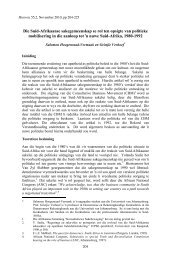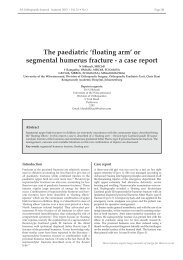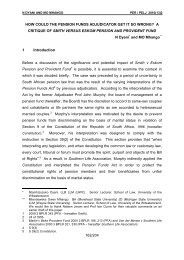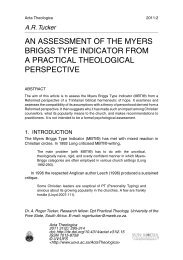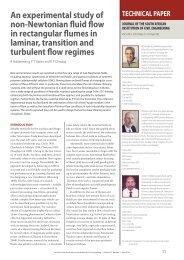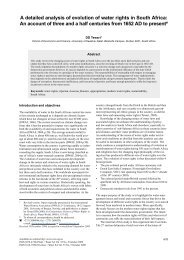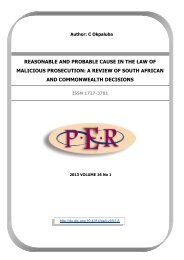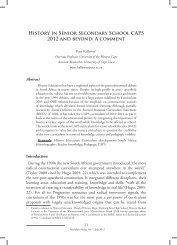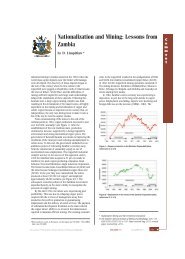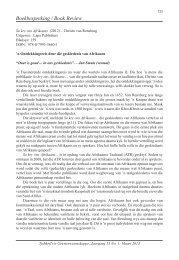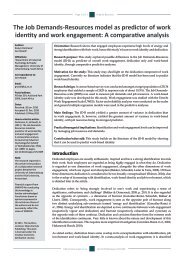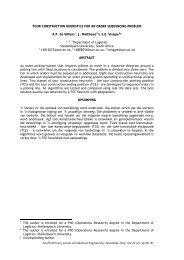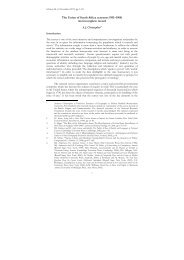Infantile tuberculous osteomyelitis of the proximal tibia involving the ...
Infantile tuberculous osteomyelitis of the proximal tibia involving the ...
Infantile tuberculous osteomyelitis of the proximal tibia involving the ...
Create successful ePaper yourself
Turn your PDF publications into a flip-book with our unique Google optimized e-Paper software.
Page 84 / SA ORTHOPAEDIC JOURNAL Spring 2012 | Vol 11 • No 3<br />
CASE REPORT AND REVIEW OF THE LITERATURE<br />
C A S E R E P O RT A N D<br />
R E V I E W O F T H E L I T E R AT U R E<br />
<strong>Infantile</strong> <strong>tuberculous</strong> <strong>osteomyelitis</strong> <strong>of</strong> <strong>the</strong><br />
<strong>proximal</strong> <strong>tibia</strong> <strong>involving</strong> <strong>the</strong> growth plate<br />
WB Hiddema MBChB<br />
Community Service Medical Officer, Department <strong>of</strong> Orthopaedics<br />
BW Barnard MBChB<br />
Medical Officer, Department <strong>of</strong> Radiology<br />
W Bouaicha<br />
Orthopaedic Specialist (Tunisia); Consultant, Department <strong>of</strong> Orthopaedics<br />
D Hurter MBChB, MMed(DRad)<br />
Head: Department <strong>of</strong> Radiology<br />
GD van der Linde MBChB, MMed(Path)<br />
Consultant, Department <strong>of</strong> Pathology<br />
CA van der Westhuizen MBChB, MMed(Ortho), FCS(Ortho)SA<br />
Head: Department <strong>of</strong> Orthopaedics<br />
PB Yero<br />
Orthopaedic Specialist (Cuba); Consultant, Department <strong>of</strong> Orthopaedics<br />
Kimberley Hospital, Kimberley, Free State<br />
Reprint requests:<br />
Dr WB Hiddema<br />
Email: wim.hiddema@gmail.com<br />
Tel: (+27)72 289 7072<br />
Abstract<br />
With an ever-increasing prevalence <strong>of</strong> tuberculosis (TB) in Sub-Saharan Africa it is now more important than<br />
ever to consider tuberculosis when drawing up a list <strong>of</strong> differentials in musculoskeletal disease. We present a case<br />
<strong>of</strong> infantile <strong>tuberculous</strong> <strong>osteomyelitis</strong> <strong>of</strong> <strong>the</strong> <strong>proximal</strong> <strong>tibia</strong> <strong>involving</strong> <strong>the</strong> growth plate.<br />
Key words: Musculoskeletal tuberculosis, <strong>tuberculous</strong> <strong>osteomyelitis</strong>, epiphyseal tuberculosis, metaphyseal tuberculosis,<br />
extrapulmonary tuberculosis<br />
Case report<br />
A 22-month-old boy presented with a three-month history<br />
<strong>of</strong> a painful mass over his left lower leg following a fall<br />
onto his left knee.<br />
Fur<strong>the</strong>r history revealed a previously healthy child with<br />
a normal birth developmental history. All his vaccinations,<br />
including BCG, were up to date.<br />
Of note in <strong>the</strong> history was <strong>the</strong> fact that his mo<strong>the</strong>r had<br />
been diagnosed with pulmonary tuberculosis (TB) and<br />
started on treatment two months prior to his presentation<br />
to us. The child had been subsequently screened for tuberculosis<br />
with a Mantoux skin test at his local clinic which<br />
was positive. He was <strong>the</strong>n also started on initial phase<br />
anti-TB chemo<strong>the</strong>rapy consisting <strong>of</strong> rifampicin, isoniazid<br />
and pyrazinamide. Both mo<strong>the</strong>r and child were compliant<br />
with <strong>the</strong>ir treatment.<br />
General and systemic examination was normal.
CASE REPORT AND REVIEW OF THE LITERATURE SA ORTHOPAEDIC JOURNAL Spring 2012 | Vol 11 • No 3 / Page 85<br />
The local examination revealed an obvious swelling over<br />
<strong>the</strong> medial aspect <strong>of</strong> his left <strong>proximal</strong> <strong>tibia</strong> with normal overlying<br />
skin and no focal temperature change. The mass was<br />
fluctuant, minimally tender and non-pulsatile on palpation<br />
and without an associated knee effusion. The child had a<br />
normal gait and full painless passive range <strong>of</strong> motion <strong>of</strong> his<br />
left knee. No neurovascular compromise <strong>of</strong> his left lower<br />
limb was noted. The left hip and ankle joints were normal.<br />
The infective markers were not significantly raised:<br />
Erythrocyte sedimentation rate (ESR) was 20 ml hour and<br />
C-reactive protein (CRP) was 5.1. The leucocyte count was<br />
9.49 × 109/L with a normal differential count.<br />
On <strong>the</strong> AP X-ray <strong>of</strong> <strong>the</strong> left knee moderate s<strong>of</strong>t tissue<br />
swelling over <strong>the</strong> medial aspect <strong>of</strong> <strong>the</strong> left knee was seen, as<br />
well as a lytic lesion measuring 0.5 cm × 1 cm on <strong>the</strong> medial<br />
aspect <strong>of</strong> <strong>the</strong> <strong>proximal</strong> <strong>tibia</strong>l metaphysis (Figure 1).<br />
MRI revealed a cold abscess, originating in <strong>the</strong> <strong>proximal</strong><br />
<strong>tibia</strong>l epiphysis and extending transphyseal into <strong>the</strong> metaphysis<br />
as well as into <strong>the</strong> surrounding s<strong>of</strong>t tissues. No effusion<br />
or articular involvement was noted (Figure 2).<br />
A provisional diagnosis <strong>of</strong> TB <strong>osteomyelitis</strong> was made and<br />
<strong>the</strong> child was subsequently taken to <strong>the</strong>atre for incision,<br />
drainage and curettage.<br />
Intra-operatively a thick-walled abscess cavity containing<br />
serous fluid was found in <strong>the</strong> s<strong>of</strong>t tissues on <strong>the</strong> medial<br />
aspect <strong>of</strong> <strong>the</strong> left <strong>proximal</strong> lower leg with a tractus extending<br />
into <strong>the</strong> growth plate (Figure 3). The fluid was aspirated for<br />
MCS and biopsies were taken for histopathological evaluation.<br />
Figure 2. Transphyseal extension (arrow) as seen on<br />
<strong>the</strong> MRI (T1 post-Gadolinium coronal view)<br />
The child had been screened for tuberculosis with a<br />
Mantoux skin test at his local clinic which was positive<br />
Figure 3. Tractus found extending into growth<br />
plate during surgery (arrow)<br />
Figure 1. AP X-ray <strong>of</strong> <strong>the</strong> left knee demonstrating<br />
<strong>the</strong> lytic lesion (arrow) in <strong>the</strong> <strong>proximal</strong> <strong>tibia</strong>l metaphysis<br />
Histological examination confirmed <strong>tuberculous</strong> granulomas<br />
with Langhans giant cells (Figure 4). No acid-fast<br />
bacilli were seen with microscopy and culture results were<br />
negative, which could be attributed to <strong>the</strong> fact that <strong>the</strong><br />
patient had already been on anti-TB chemo<strong>the</strong>rapy for<br />
two months prior to <strong>the</strong> biopsy.<br />
Post-operatively <strong>the</strong> child recovered well and was discharged<br />
on continuation phase anti-TB chemo<strong>the</strong>rapy<br />
(rifampicin and isoniazid) for ano<strong>the</strong>r 9 months.<br />
The importance <strong>of</strong> monitoring <strong>the</strong> child’s growth over<br />
<strong>the</strong> next several years was discussed with <strong>the</strong> parents.
Page 86 / SA ORTHOPAEDIC JOURNAL Spring 2012 | Vol 11 • No 3<br />
CASE REPORT AND REVIEW OF THE LITERATURE<br />
Skeletal tuberculosis accounts for around<br />
10 to 20 per cent <strong>of</strong> all extrapulmonary TB cases and only<br />
between 1 and 2 per cent <strong>of</strong> all TB cases<br />
Figure 4. Granuloma formation as seen on<br />
histology<br />
Literature review<br />
In 2009, 9.4 million new cases <strong>of</strong> tuberculosis were reported.<br />
1 Skeletal tuberculosis accounts for around 10 to 20 per<br />
cent <strong>of</strong> all extrapulmonary TB cases and only between 1<br />
and 2 per cent <strong>of</strong> all TB cases. 2 However concurrent pulmonary<br />
TB is present in less than 50 per cent <strong>of</strong> skeletal<br />
tuberculosis cases in children. 3 The axial skeleton is most<br />
commonly involved in adults, while peripheral skeletal<br />
involvement is more common among children. 4 The commonly<br />
affected sites in TB <strong>osteomyelitis</strong> are, in order <strong>of</strong><br />
frequency, <strong>the</strong> spine, femur, <strong>tibia</strong> and fibula. 5<br />
TB bacilli reach <strong>the</strong> <strong>proximal</strong> <strong>tibia</strong> by haematogenic<br />
spread resulting in a metaphyseal focus. In children<br />
younger than one-and-a-half years fur<strong>the</strong>r spread to <strong>the</strong><br />
epiphysis occurs through <strong>the</strong> patent transphyseal vessels<br />
from this metaphyseal focus. 2 A concomitant septic<br />
arthritis can result following drainage <strong>of</strong> an epiphyseal<br />
abscess into <strong>the</strong> joint through <strong>the</strong> articular surface, and<br />
physeal involvement is explained by direct spread from an<br />
adjacent metaphyseal or epiphyseal abscess.<br />
In most cases, <strong>the</strong> diagnosis <strong>of</strong> <strong>tuberculous</strong> <strong>osteomyelitis</strong><br />
is delayed by up to 6 months. It usually presents as<br />
swelling only or swelling and stiffness or pain. 6<br />
Radiological signs include, but are not limited to:<br />
changes in <strong>the</strong> joint space, subchondral erosions, lytic<br />
bone lesions and articular osteopaenia. 7 Markers <strong>of</strong> acute<br />
infection or inflammation including ESR and CRP are elevated<br />
but are non-specific. 8 A definite diagnosis must be<br />
made by biopsy and culture. 7,9<br />
Treatment can consist <strong>of</strong> ei<strong>the</strong>r TB chemo<strong>the</strong>rapy alone<br />
or surgical debridement and TB chemo<strong>the</strong>rapy, but many<br />
authors believe TB chemo<strong>the</strong>rapy alone for 9 to 12<br />
months to be sufficient. 9,10<br />
Even though open curettage is widely performed and<br />
accepted as <strong>the</strong> norm, Takashi et al provide an interesting<br />
minimally invasive endoscopic technique to minimise<br />
physeal damage with curettage <strong>of</strong> transphyseal lesions.<br />
They conclude that <strong>the</strong>re may be potential advantage in <strong>the</strong><br />
use <strong>of</strong> endoscopic ra<strong>the</strong>r than open methods <strong>of</strong> debridement<br />
<strong>of</strong> such lesions. 11<br />
Osteomyelitis <strong>of</strong> <strong>the</strong> <strong>proximal</strong> <strong>tibia</strong> can potentially have<br />
devastating long-term complications such as premature<br />
joint degeneration and longitudinal growth disturbance.<br />
Premature joint degeneration follows epiphyseal destruction<br />
while longitudinal growth disturbance is a result <strong>of</strong><br />
physeal destruction. Song and Kim 12 reported on three cases<br />
<strong>of</strong> non-<strong>tuberculous</strong> <strong>osteomyelitis</strong> <strong>involving</strong> <strong>the</strong> <strong>proximal</strong><br />
<strong>tibia</strong>l epiphyses with an eight to 22-year follow-up. They<br />
conclude that <strong>the</strong> epiphysis has remarkable potential for<br />
recovery and regeneration and <strong>the</strong>refore advise expectant<br />
management <strong>of</strong> <strong>the</strong> bony epiphyseal defects. However, with<br />
regard to <strong>the</strong> physeal destruction, <strong>the</strong>y advise an early<br />
osteotomy (before 4 years) to correct angular deformities as<br />
recurrence <strong>of</strong> angular deformity was not seen in <strong>the</strong>ir longterm<br />
follow-up and <strong>the</strong> growth plate can recover its potential<br />
for symmetrical growth once normal alignment has<br />
been restored.<br />
Kozo et al 13 report a case <strong>of</strong> a 30-month-old infant with TB<br />
<strong>of</strong> <strong>the</strong> <strong>proximal</strong> <strong>tibia</strong> <strong>involving</strong> <strong>the</strong> growth plate, where<br />
extensive surgical curettage <strong>of</strong> <strong>the</strong> growth plate was initially<br />
done resulting in no long-term growth abnormalities. This<br />
emphasises once again <strong>the</strong> tremendous potential <strong>of</strong> <strong>the</strong><br />
physis to withstand <strong>the</strong> damage caused by both <strong>the</strong> infection<br />
and <strong>the</strong> surgical curettage and <strong>the</strong> ability to continue with<br />
symmetrical growth after such an insult.<br />
Discussion<br />
As is evident from <strong>the</strong> aforementioned literature, infantile<br />
<strong>tuberculous</strong> <strong>osteomyelitis</strong> <strong>of</strong> <strong>the</strong> <strong>proximal</strong> <strong>tibia</strong> is only very<br />
rarely encountered.<br />
This article serves as a reminder that in order to make an<br />
early diagnosis <strong>of</strong> TB <strong>osteomyelitis</strong> in children, a high index<br />
<strong>of</strong> suspicion is needed, and it should definitely be included<br />
on <strong>the</strong> list <strong>of</strong> differentials in children with musculoskeletal<br />
complaints <strong>of</strong> swelling and stiffness. Fur<strong>the</strong>rmore it should<br />
be kept in mind that <strong>the</strong> absence <strong>of</strong> pulmonary TB does not<br />
exclude <strong>the</strong> diagnosis <strong>of</strong> infantile <strong>tuberculous</strong> <strong>osteomyelitis</strong>.<br />
Long-term anti-TB chemo<strong>the</strong>rapy following initial<br />
debridement yields good short-and long-term results as<br />
seen in several case reports, with only a few growth-related<br />
complications. As it is a rare condition fur<strong>the</strong>r reports with<br />
long-term follow-up are warranted. This will provide us<br />
with adequate data enabling us to better comment on <strong>the</strong><br />
prognosis regarding long-term growth disturbances in children<br />
with TB <strong>osteomyelitis</strong> <strong>involving</strong> <strong>the</strong> physis.<br />
No benefit has been received by <strong>the</strong> authors <strong>of</strong> this article<br />
and no perverse incentives were <strong>of</strong>fered to <strong>the</strong> patient<br />
and/or family.
Case repOrt and review OF tHe Literature sa OrtHOpaediC JOurnaL spring 2012 | vol 11 • no 3 / page 87<br />
References<br />
1. world Health Organization. report on global tuberculosis<br />
control. 2010. http://whqlibdoc.who.int/publications/2010/<br />
9789241564069_eng.pdf<br />
2. Morris Bs, varma r, Gang a, et al. Multifocal musculoskeletal<br />
tuberculosis in children: appearances on computed<br />
tomography. Skeletal Radiol 2002; 31:1-8.<br />
3. teo HeL, peh wCG. skeletal tuberculosis in children.<br />
Pediatric Radiol 2004; 34:853-60.<br />
4. vohra r, Kang Hs, dogra s, saggar rr, sharma r.<br />
tuberculosis <strong>osteomyelitis</strong>. J Bone Joint Surg [Br] 1997;<br />
79:562-66.<br />
5. vallejo JG, Ong Lt, starke Jr. <strong>tuberculous</strong> <strong>osteomyelitis</strong> <strong>of</strong><br />
<strong>the</strong> long bones in children. Paediatr Infect Dis J 1995; 14:524-<br />
26.<br />
6. Chen sC, Huang sC, wu Ct. non-spinal tB <strong>osteomyelitis</strong> in<br />
children. J Formos Med Assoc 1998; 97(1): 26-31.<br />
7. Hosalkar Hs, agrawal n, reddy s, sehgal K, Fox eJ, Hill ra.<br />
skeletal tuberculosis in children in <strong>the</strong> western world: 18<br />
new cases with a review <strong>of</strong> <strong>the</strong> literature. J Child Orthop 2009;<br />
3(4):319-24.<br />
8. Gunasekera tMr, Karunathilake dH, Jayaweera KaHM. a<br />
rare presentation <strong>of</strong> <strong>tuberculous</strong> <strong>osteomyelitis</strong> in childhood.<br />
Sri Lanka Journal <strong>of</strong> Child Health 2008; 37:61-62.<br />
9. rasool Mn. Osseous manifestations <strong>of</strong> tuberculosis in children.<br />
J Paediatric Orthop 2001; 21(6):746-55.<br />
10. Monach pa, daily Jp, rodriguez-Herrera G, solomon dH.<br />
<strong>tuberculous</strong> <strong>osteomyelitis</strong> presenting as shoulder pain. J<br />
Rheumatol 2003; 30(4):851-56.<br />
11. takashi s, Makoto K, atsuya w, nobuyasu O, Kazuhisa t.<br />
endoscopic surgery for Chronic Osteomyelitis extending<br />
across <strong>the</strong> physis: a report <strong>of</strong> two Cases. J Bone Joint Surg<br />
[am] 2008; 90(8):1744-50.<br />
12. song Ks, Kim HKw. regeneration <strong>of</strong> <strong>the</strong> <strong>proximal</strong> <strong>tibia</strong>l epiphysis<br />
after infantile <strong>osteomyelitis</strong>: report <strong>of</strong> three cases with<br />
an eight to 22 year follow-up. J Bone Joint Surg [Br] 2005<br />
87(7):979-83.<br />
13. Kozo O, Hideji K, toshihiko Y, naoki O. Long-term followup<br />
<strong>of</strong> tuberculosis <strong>of</strong> <strong>the</strong> <strong>proximal</strong> part <strong>of</strong> <strong>the</strong> <strong>tibia</strong> <strong>involving</strong><br />
<strong>the</strong> growth plate: a case report. J Bone Joint Surg [am]<br />
2007;89(2):399-403.<br />
• SAOJ<br />
SA O RT H O PA E D I C J OU R NA L<br />
p e e r r e v i e w e r s<br />
( pa s t a n d p r e s e n t)<br />
Ally M Pr<strong>of</strong><br />
Biddulph S Pr<strong>of</strong><br />
Birkholtz F F Dr<br />
Bosman M Pr<strong>of</strong><br />
Burger D Mnr<br />
Close V M Dr<br />
Coetzee C Pr<strong>of</strong><br />
Coetzee E Dr<br />
Colyn H J S Dr<br />
Conradie A Dr<br />
Daneel P J Dr<br />
de Beer G J E Dr<br />
de Beer J F Dr<br />
de Beer M A Dr<br />
de Jongh A G V Dr<br />
de Kock W J Dr<br />
de la Harpe A Dr<br />
de Lange L J Dr<br />
de Vos J N Dr<br />
Dove M G Pr<strong>of</strong><br />
Dreyer G Pr<strong>of</strong><br />
du Plessis D C Dr<br />
du Plessis D Pr<strong>of</strong><br />
du Toit G T Dr<br />
Dunn R N Dr<br />
Eisenstein S Pr<strong>of</strong><br />
Erasmus P J Dr<br />
Erken E H W Pr<strong>of</strong><br />
Erlank E Dr<br />
Ferreira A P Dr<br />
Ferreira M Dr<br />
Flemming J Pr<strong>of</strong><br />
Frantzen D J M Dr<br />
Franz R C Pr<strong>of</strong><br />
George J A Pr<strong>of</strong><br />
Goga I E Pr<strong>of</strong><br />
Golele R Pr<strong>of</strong><br />
Govender S Pr<strong>of</strong><br />
Gräbe J C Dr<br />
Gräbe R P Pr<strong>of</strong><br />
Grobbelaar C J Dr<br />
Hastings C J Dr<br />
H<strong>of</strong>fman E B Pr<strong>of</strong><br />
Hough S Pr<strong>of</strong><br />
Janse v Rensburg Pr<strong>of</strong><br />
Koekemoer D Dr<br />
Kohnke W Dr<br />
Kruger J Dr<br />
Lautenbach E E G Dr<br />
Le Roux T L B Pr<strong>of</strong><br />
Lindeque B G P Pr<strong>of</strong><br />
Louw J A Dr<br />
Lukhele M Pr<strong>of</strong><br />
Malan M M Dr<br />
Marais K Dr<br />
Maraspini C Dr<br />
Maritz N G J Pr<strong>of</strong><br />
Mennen E Dr<br />
Mennen U Pr<strong>of</strong><br />
McCarthy E Dr (USA)<br />
Molteno R G Dr<br />
Motsitsi N S Dr<br />
Muller E W Dr<br />
Myburgh J G Dr<br />
Naude M C Dr<br />
Olivier C J Dr<br />
Peach A Dr<br />
Pelser E Dr<br />
Pettifor J M Pr<strong>of</strong><br />
Potgieter D Dr<br />
Potgieter J Dr<br />
Pretorius J A Dr<br />
Rasool M N Dr<br />
Rösch T G Dr<br />
Schepers A Pr<strong>of</strong><br />
Schnitzler C M Pr<strong>of</strong><br />
Shipley J A Pr<strong>of</strong><br />
Smit J P J Dr<br />
Snowdowne R B Pr<strong>of</strong><br />
Snyckers C Dr<br />
Snyckers H M Dr<br />
Sparks L T Dr<br />
Stiglingh W Dr<br />
Swart J Pr<strong>of</strong><br />
Sweet M B E Pr<strong>of</strong><br />
Theron F de V Dr<br />
van der Westhuizen J Dr<br />
van Niekerk J J Dr<br />
van Papendorp D Pr<strong>of</strong><br />
van Wingerden J Dr<br />
van Wyk L Dr<br />
van Zyl A A Dr<br />
Venter J A Dr<br />
Venter P J Dr<br />
Vermaak H Pr<strong>of</strong><br />
Visser C C Dr<br />
Vlok G J Pr<strong>of</strong><br />
Wade W J Dr<br />
Walters J Pr<strong>of</strong><br />
Webber L Pr<strong>of</strong><br />
Weber F A Pr<strong>of</strong><br />
Zondagh I Dr



